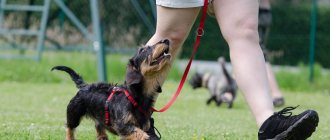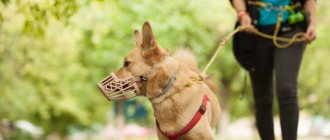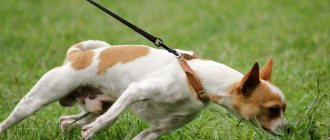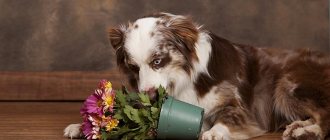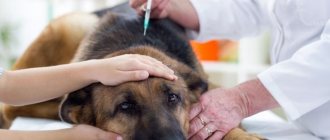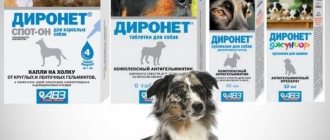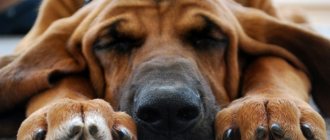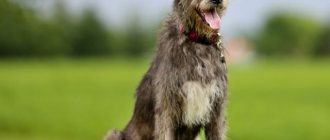At what age is it recommended to take a puppy away from its mother?
When getting a dog for the first time, owners want to know at what age it is recommended to take the puppy away from its mother.
Experts say the earliest weaning period is 8 to 10 weeks. By this time, puppies that receive a sufficient amount of mother's milk develop artificial immunity, milk teeth appear, the intestines are populated with microflora, and certain rules of behavior are developed.
Note! Naturally fed puppies double their body weight in one week, while bottle-fed puppies will take two weeks.
- In some cases, dog experts advise taking slightly older puppies at the age of 4-5 months. This applies to families with small children. Without calculating their strength, they can accidentally injure a defenseless creature.
- It will be easier for older people to cope with a baby who is accustomed to a certain diet, a toilet, who knows his place and a few simple commands.
- It is easier for owners choosing “show” dogs to evaluate the puppy’s exterior features, which appear at six months of age.
What you need to prepare in the house before the puppy arrives
Knowing what needs to be prepared in the house before the puppy arrives, you can prevent the occurrence of most problems, make caring for your pet easier and make his stay comfortable and safe. To do this, you should purchase a special bed or bedding, care items, food, toys, and a minimum set of medications. It is advisable to remove all carpets and rugs from the floor so as not to be nervous about the puddles that appear on them.
Important Safety Instructions
Puppies are curious creatures that need to test their teeth on all the objects around them. And since many of them pose a threat to life, you should follow important safety rules by removing the following things from the floor and other accessible places:
- household chemicals, varnishes, paints and other toxic drugs;
- wires;
- threads;
- buttons, baby mosaics, beads and other small objects that the baby can swallow or inhale;
- medicines;
- floor candles;
- products made of foam plastic and foam rubber;
- cutting and piercing objects;
- plastic bags;
- shoes and clothes.
If there is a small child in the family, then you need to make sure that there is no diaper in the pet’s access area. He may rupture it and swallow the gel-like filler.
Important! When removing “dangerous” things, do not forget about the computer system unit, which often stands on the floor or on the bottom shelf of the table.
Choosing a place to feed
From the first days, the puppy must be taught to consume food in one place. To do this, you need to buy 2 bowls in advance (for food and water).
Important! Arching your back when feeding can lead to curvature of the spine and sagging of the abdomen. This is especially true for dachshunds, mastiffs and other dogs with long bodies. To avoid this, you should place the bowls on a special stand or a small elevation at the level of the shoulder joints.
When choosing a place for feeding, you must follow the rules of hygiene. For small, smooth-haired dogs, you can designate a corner in the kitchen. But for representatives of large and long-haired breeds, a corridor is more suitable. This will prevent hair from appearing on the table, dishes and prepared food.
The floor surface in the feeding area should be free of rugs and paths so that it can be easily washed and disinfected if necessary.
Note! Food left after feeding should be immediately put into the refrigerator, but clean water should be available at all times.
Place to sleep
You can equip a place to sleep with a basket, a lounger or a thick bedside rug. On the first day, the baby is afraid to be alone in the dark in an unfamiliar house, so at night he should be left in the bedroom near the bed. Of course, you need to be prepared for a sleepless night, as the puppy will whine, look for mom, bark, and scratch the floor and door. In this case, you should get up, take him in your arms (but not into bed), stroke him and calm him down, and when going to bed, turn on the night light .
In the future, it is necessary to allocate a specific place for the dog where it will sleep and rest. Central heating radiators or heating devices should not be placed nearby, and there should be no drafts in the room.
Toys
To prevent your puppy from starting to chew shoes, upholstery and wallpaper out of boredom, he must have his own toys. You should not buy rubber and plastic figures in a regular children's store, as he can tear them with his teeth, injure the oral cavity and swallow small pieces. The same applies to soft toys that cannot withstand the “onslaught” of sharp teeth.
There are toys intended for indoors and outdoors.
Street ones include:
- rubber balls;
- Frisbee;
- skittles;
- rubber or plastic rings.
Home entertainment items include vinyl and latex bones, animals, and balls that can be chewed and rolled on the floor. Some dogs like toys that make sounds when pressed.
During the period of teeth change, puppies will find toys made from dried veins, which they will chew with pleasure.
It is better to immediately buy several toys of different shapes and materials, and then alternate them. In this way, you can easily calculate which object your baby likes to play with more than others.
Some dogs enjoy playing with soft toys. But they must be washed often and replaced as they become unusable.
Collar and harness
When choosing between a collar and a harness, you need to take into account the breed of your pet, its temperament and purpose.
For miniature dogs (Yorkshire terrier, Italian Greyhound, Chihuahua, etc.), which, due to fragile cervical vertebrae, are contraindicated for additional load in the form of a collar, a harness is suitable. This group also includes puppies of breeds characterized by a shortened muzzle structure (pugs, sharpeis, bulldogs, Pekingese).
For other dogs, the best option would be a walking collar made of high-quality materials and equipped with a soft padding that prevents compression of the neck.
As the puppy grows, he will need a training collar equipped with special half-rings or loops for maximum control and management on the part of the owner or instructor.
A bowl
The first thing you need to buy for your dog is a bowl. It would seem like ordinary dishes, but even here there are some nuances. When choosing it, you should pay attention to functionality. A beautiful bowl made of glass or ceramic is certainly good, but if you accidentally break it, the dog can be injured by the fragments. Therefore, bowls for animals are purchased exclusively from plastic or metal.
Alabai: weight of an adult dog and puppy by month
Then you should decide on the size of the bowl, which most often depends on the size of the dog itself and its appetite. 200 ml containers are suitable for Chihuahuas, toy terriers and other small decorative breeds. 450 ml - for small and medium-sized dogs, 750 ml - for pugs and bulldogs, and those that are larger - for large dogs (Great Dane, Labrador, Shepherd, Doberman, etc.).
Note! The dog should have two bowls - one for food and the other for water.
An important role is played by the level at which the bowl is located. It should be at the level of the dog's chest. This is due to the fact that by bending down to eat, the dog takes in excess air during the feeding process, which can then affect digestion and cause excess bloating. To adjust the bowl to the required level, you need a special stand. A puppy can do without it, but the older the dog, the more necessary this item is.
Convenient stand prevents air from entering along with food
Introducing the puppy to its new home
It’s best to start introducing the puppy to its new home in one room, but you should leave the doors open. Let him move freely, sniffing the new unfamiliar space.
If the puppy shows signs of panic, whines, stomps around in one place, or, conversely, makes sudden movements and bumps into foreign objects, then you should pick him up and calm him down with light stroking. Some dogs calm down when they get into the confined space of a basket, cage or playpen.
Puppy behavior in the first days in a new home
It is very important from the first day not to allow the puppy to commit actions for which he will subsequently receive punishment. In this case, pity is inappropriate, as it entails disobedience and problems with education.
Having become accustomed to the new environment, the dog begins to arrange peculiar tests for the owners in the form of demonstrative urination in the wrong place, begging for goodies from the table, falling asleep in the bed or on the sofa, chewing books, shoes, clothes and other items. If you do not immediately stop such actions, they will become the norm, and it will be very difficult to retrain your pet.
How to behave with a puppy
Owners should remember the golden rule: “The pet should be praised for the right actions, and scolded for the bad ones.” This seems to be an obvious truth, but many are afraid to be strict with the “sweet creature.”
- First, the punishment must be fair. You should NEVER take your anger and bad mood out on your pet! This will cause misunderstanding and resentment on his part.
- Secondly, it must be timely. You cannot punish a puppy in the evening for puddles or spoiled things in the morning.
- Thirdly, when punishing a dog, you need to feel love and compassion for it, like a naughty child. Punishment for the sake of demonstrating one's own strength is categorically unacceptable.
- Fourthly, it should be understood that the severity shown is for the good. Example: punishing a puppy who ran after a cat will save his life in the future by preventing him from falling under the wheels of a moving vehicle.
- Fifthly, the proportionality of the punishment and the offense must be observed. For a puddle in the wrong place or an overturned flower pot, you can limit yourself to a stern voice, but the manifestation of aggression should be immediately stopped by physical force. This is especially true for such “serious” breeds as Rottweilers, bull terriers, pit bull terriers, Dobermans, German shepherds, etc. A dog that has “the advantage of the last blow” will become uncontrollable and will keep all family members at bay.
Speaking of encouragement, it is also necessary to clarify what should be considered praise, since in their blind love, owners begin to overindulge their pets, causing irreparable harm to their health.
We are talking about sweets, pieces of sausage, buns, canned food and other “human” delights that lead to digestive disorders, allergies, problems with the liver and kidneys, and also provoke the growth of cancer cells. For good behavior or correctly executed commands, it is better to give your pet special biscuits purchased at a pet store.
Important! The best reward for a dog is a sincere show of love from its owner. An affectionate word, a smile, a stroke or a friendly rub behind the ear makes her happy.
Things to do with your puppy
When going over in your mind the options for what you can do with your puppy, it is better to opt for moderately active games with elements of a general training course.
Note! Until the puppy has completed the full course of necessary vaccinations, he is prohibited from walking on the street or in dog parks.
How to prepare for the arrival of a puppy in the house
With the advent of a baby, the family’s usual way of life changes. The first days of a puppy in a new home are not only endless tenderness and delight for all household members. This is also a lot of worries, troubles, and new responsibilities. In order not to forget anything important that is necessary for the pet’s comfortable adaptation and adaptation, you should prepare in advance.
Collar or harness
You have decided on the breed of your pet, which means you can choose a collar or harness for it. The pet store will definitely tell you the size and material of the ammunition for the selected breed. So for kids (Yorkie, Chihuahua, Dachshund) soft textile collars are suitable; for larger dogs you can choose a dense, but thin and leather one. For puppies of some breeds, you should choose a harness, preferably a synthetic one. All items of equipment must be adjustable in order to fit the pet perfectly.
Address book
Not an essential item, but if the pet's name is already known, you can order a special tag. On it, indicate the dog's name, your phone number or address, so that if necessary, you can be found. The tag attaches to a collar or walking harness and greatly increases the chances of finding your pet if it gets lost.
Leash
A must-have accessory for your first walks. It is better to give preference to a roulette leash with an adjustable length. This will allow you to fully control your baby on his first walks, giving him the right amount of freedom while ensuring complete safety. Choose a regular leash of medium length, strong and dense, with a high-quality carabiner fastening.
Bed
The new family member needs his own sleeping place. For a small puppy, this should be a place where he will be cozy, comfortable, where he will feel completely safe, especially in the first days. The bed should be the right size, not too tight, but not too big. The puppy should be able to lie stretched out to its full height. Give preference to natural materials - breathable, hypoallergenic.
A huge variety of models and colors will allow you to choose a bed for your pet, which will not only become his favorite place to relax, but also to play.
Bowls for food and water
Something you absolutely cannot do without. A large selection of dishes made of plastic, metal or ceramics of various sizes will allow you to choose the best dishes for your pet. Choose a practical, easy-to-clean bowl that is slightly larger than the serving size for one meal.
Nutrition
You should also decide on the choice of diet for your pet in advance, if possible before the puppy arrives in your home. What to choose - natural food or dry food depends on your preferences, capabilities and desires. Natural food for dogs will require some effort on your part to plan the diet and time to prepare the food. Many owners consider dry dog food to be the best option, both in terms of convenience, practicality, cost-effectiveness and benefits for the dog.
Toys
Now not only a wonderful bundle of happiness will live in your home, but also various toys that sometimes make sharp sounds. They are needed to entertain your baby, keep him company in your absence, help his teething and protect your furniture, shoes and other important things from the inglorious fate of being eaten by a growing dog. Make sure your puppy has something to play with and have fun with.
Treats
Special treats for dogs - dried paws, sinews, offal, cookies - this is what should be in your home from now on and forever. With their help, the dog is educated, encouraged, entertained, treated and simply pampered. They help with teething and changing teeth, keep your pet occupied for a while if you need to go away, and simply make them happy.
If there are already animals in the house
Problems with the puppy's adaptation may arise if there are already animals in the house. In this case, the owner must have certain knowledge and be patient in order to make friends with their pets.
Cats
The acquaintance and adaptation of a newly born puppy and a cat already living in the house should follow a certain pattern.
- For the first 2-3 days, the puppy should be kept in a separate room, avoiding contact with the cat.
- Release the puppy, giving him the opportunity to explore all the premises. At this time, the cat must be removed from the house.
- Return the pets to their places and let the cat get used to the foreign smell.
- Place the puppy in a transparent container or box with small holes through which he cannot escape. Bring the cat into the room and allow it to examine and sniff the new pet.
- If the animals have not shown aggression towards each other, then you can get to know them better. To do this, you need to ask someone to hold the puppy on a leash and hold the cat with your hands, not allowing you to approach at a “dangerous” distance. In most cases, 3-4 such sessions are required for complete adaptation.
Next, you should allow pets to be in the same room in the presence of their owners. Once you are sure that they are used to each other's company, you can leave them alone.
Important! You cannot bring a puppy if there is a nursing cat with kittens in the house. While protecting her offspring, she will show aggression and may injure her new pet.
Other dogs
If there are other dogs in the house, you should agree in advance with the owner of the puppy about the possibility of returning it in the event of a discrepancy in character.
Dog experts advise carrying out the first acquaintance on neutral territory in order to balance the chances of both sides. After letting the dogs examine and sniff each other, you can take a short walk together, after which you can go home.
Even if the older dog does not show aggression towards the newcomer, you should not leave them alone for the first 2-3 days. And only after making sure that there is no danger to the baby’s health can you entrust his partial upbringing to an adult animal.
Rodents and birds in cages
If rodents and birds already live in cages in the house, then after the puppy arrives, they should not be allowed to move freely around the room.
At first, the cages should be placed on high pieces of furniture where the puppy cannot reach, and when leaving the house, it is better to take them to another room.
You need to be especially careful with representatives of hunting breeds, since for them all small animals are potential prey.
Puppy space and safety
What does a puppy need? The first thing you should worry about is arranging a place for the dog. It is worth choosing a site located in a quiet, secluded area, protected from drafts and warm enough. However, there is no need to place the bed directly next to the battery.
Even if a dog starts in his own home, you can’t immediately throw him out into a kennel on the street. For the first few weeks, the baby should be kept indoors. Especially if he has not yet received the necessary vaccinations. Subsequently, the animal can be moved to an enclosure or a booth with a canopy.
Sun lounger
An important point in the question of what a dog needs is a bed. Of course, just sleeping on the floor or ground will be uncomfortable for the dog, and the small puppy will also freeze. A special bed can be bought at a pet store or ordered online. In this case, it is selected depending on the breed and size of the animal. It is taken for growth so that it is suitable for an adult dog.
The second option is to make a sunbed yourself. This could be an old blanket and pillows. The main thing is that the dog is warm and comfortable. It is worth remembering that some breeds like to bury themselves in fabric; separate capes are placed for them.
Important! You should not move the lounger from place to place. The puppy must know its location exactly. This will make it easier to teach him basic commands.
Fence and playpen
Both owners of large breeds and those who have taken a miniature dog into their home may need a fence or a special playpen. In the first case, they are needed to avoid damage to property. This is especially true for breeds such as huskies, which simply cannot sit still.
If a representative of a small breed lives in a large house, a playpen will also come in handy. This will help avoid a situation where the baby climbs where he shouldn’t. Accordingly, the number of injuries will be significantly reduced.
Treats for pets
What to feed a puppy for the first days
The owner should decide in advance what to feed the puppy for the first days and purchase the necessary products or ready-made food.
You should not start complementary feeding with dry ready-made food. In the first days, it is better to give preference to ready-made canned food and pates. Some experts allow feeding dry granules soaked in warm water, broth or milk.
Important! The quality of feed should be no lower than super premium class. Optimally, you need to choose holistic people.
If you decide to feed your puppy natural products, you should include in the menu:
- dietary meats;
- porridge made from buckwheat, brown rice or low-glycemic oats;
- dairy products;
- boiled carrots and zucchini;
- fish fat;
- boiled eggs.
Vitamin and mineral complexes selected according to the animal’s age should be added to the diet, but river fish and whole cow’s milk should be avoided.
Rules for organizing a toilet
There are several rules for organizing a toilet for a puppy, which make it possible for him to develop an understanding that he must do his “wet” business in a certain place.
Knowing that dogs feel the need to defecate immediately after sleeping and feeding, at this moment you should take it outside or put it in a tray (on a diaper, newspaper). If the pet has done everything correctly, then it should be rewarded with stroking and kind words.
As a result of repeated repetitions, the puppy will develop an instinct, and he will stop relieving himself in different places.
Experts do not recommend shouting at pets, much less using physical punishment, as this causes panic and fear in children of the very act of urination and defecation.
As a toilet, you can use numerous types of ready-made trays, rubberized or absorbent diapers, pieces of fabric, containers with sand or other hygroscopic filler.
If we are talking about large dogs, then they should immediately be taught to go to the toilet outside.
The puppy’s first day in a new home: where to start walking
You need to take your dog for walks every day.
Before you start walking your pet, you need to talk to the breeder and find out from him whether he has been vaccinated. The dog can be taken outside only after vaccination.
You need to prepare in advance for walks in the fresh air. You need to accustom your dog to a leash and teach him basic commands. You should walk with a small dog in quiet and deserted places.
Some people decide to have a small puppy in the house. However, before you do this, you need to figure out how to properly transport the dog and care for it.
What health problems may arise?
Owners definitely need to know what health problems may arise in puppies in the first days of being at home in order to pay attention to alarming symptoms in time and take the necessary measures.
Doesn't eat
The reason that the puppy does not eat in the first days of being in the house may be a radical change in diet. In this case, you need to contact the former owner and clarify the menu.
If refusal to feed is accompanied by lethargy, inactivity, tension and pain in the abdominal wall, vomiting, diarrhea, or nervous symptoms, then it is necessary to urgently contact a veterinarian.
Decreased appetite can be caused by intestinal parasites. Therefore, it is necessary to carry out deworming.
Sometimes food refusal is caused by overeating. An overly caring owner overfeeds his pet, thinking that this will speed up its growth and development. But in addition to decreased appetite, this leads to digestive problems, obesity, and deformation of the spine and joints.
Doesn't drink
The reason your puppy doesn't drink water could be:
- poisoning;
- blockage of the esophagus by a foreign object;
- intestinal obstruction as a result of excessive compaction of stool, accumulation of helminths, ingestion of a small foreign object or plastic bag;
- pathologies of internal organs;
- nausea caused by an infectious disease.
In any case, the dog must be urgently shown to a veterinarian, as puppies quickly become dehydrated, leading to irreversible consequences.
Before the doctor arrives, the pet should be placed in a cool room, the mouth should be moistened with water, and, if possible, a subcutaneous injection of saline should be given.
Lethargic
The reason that your pet is lethargic and apathetic may be:
- stress caused by weaning;
- overheating or cooling;
- overheating viral or bacterial infections;
- helminthic infestations.
If your baby still has an appetite and is urinating and defecating regularly, then there is no need to worry. But the absence of these factors should be a reason to contact the clinic.
Diarrhea
If a puppy begins to have diarrhea, he should be seen immediately by a veterinarian, since an acute form of viral enteritis can be fatal within a few hours.
Important! A characteristic sign of enteritis is the appearance of a fetid odor in feces, indicating decomposition of the intestinal mucosa. In this case, the time is counted in minutes. Therefore, when calling a doctor at home, you should find out by telephone what measures can be taken before his arrival.
Doesn't go to the toilet
Reasons why your pet does not go to the toilet:
- helminthic infestations;
- blockage of the intestines by a foreign object;
- flatulence as a result of overeating or intestinal obstruction;
- an incorrectly selected diet that lacks fiber or contains small chicken bones.
If the abdominal wall is painless, then it is worth giving an enema and giving a gentle laxative. But in the case of pain and fever, consultation with a specialist is necessary.
Sleeps a lot
It is normal for your puppy to sleep a lot, as long as he remains active and has an appetite during the breaks. Normally, a pet can spend up to 16 hours a day sleeping, interrupted by toileting, feeding and walks.
Interesting! Shar Pei dogs can sleep up to 20 hours a day.
Doesn't sleep at all
The main reason that the puppy does not sleep at all at first is the strong mental stress associated with a change of place of residence.
An overly sensitive baby suffers from insomnia, experiencing feelings of fear, melancholy and helplessness.
- Incorrectly placed seating area.
- Lack of outdoor walks.
- Your puppy may often wake up at night feeling hungry or thirsty.
- A disease accompanied by pain, nausea, diarrhea, etc.
Constantly whines and cries
The reason that the puppy constantly whines and cries may be nervous shock associated with weaning from its mother. In this case, the owner needs to show maximum patience and affection in order to allow the baby to feel safe.
The second reason may be pain. The pet should be examined for bruises or other injuries that it may have received during transportation. Carefully examine the oral cavity and ears, palpate the stomach and chest. If there is pain, the animal should be shown to a veterinarian.
How to calm a puppy
Toys will help the dog calm down after the move.
On the first day and night after the move and change of owner, the puppy will experience severe stress. In order for the dog to calm down faster, the owner must create the most comfortable environment for him in his new home. In this case, you need to adhere to the following tips:
- It is necessary to prepare a soft toy for the dog in advance. It will help the dog feel calmer in his new home.
- There is no need to constantly disturb the puppy. In the first days of his stay in a new place, he should sleep and rest.
- On the first night, the dog should sleep on its own bed. You can lay a diaper nearby so that the dog can go to the toilet.
